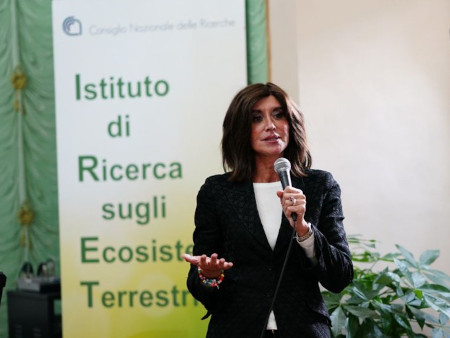On Wednesday, Nov. 13, Minister of University and Research Anna Maria Bernini visited Villa Paolina, the historic headquarters of the National Research Council’s Institute for Terrestrial Ecosystems Research (CNR-IRET), in Porano, along with local authorities and the organization’s top management. Welcoming the minister were Maria Chiara Carrozza and Giuseppe Colpani, president and director general of CNR, respectively; Laura Pernazza, president of the Province of Terni; and Carlo Calfapietra, director of CNR-IRET. After a treeclimbing demonstration, as part of which the researchers emphasized the importance of safety regulations during missions involving the sampling of taller foliage, the dignitaries present were treated to a brief illustration of the operation of some of the instrumentation in use at the research center. “The Terrestrial Ecosystems Research Institute,” said Maria Chiara Carrozza, CNR President, during the press conference, ”represents an emblem of scientific vitality on crucial issues such as biodiversity and, at the same time, of enhancement and presidium of the territory, enriched by close and fruitful connections with academia and local authorities.
The major projects in which CNR-IRET is directly involved require great vision for future prospects and a strong interdisciplinary commitment to face the great challenges ahead with the right responsibility.” CNR-IRET Director Carlo Calfapietra presented some of the Institute’s activities, recalling the national and international commitment in Research Infrastructures of which the institution is the lead partner, such as the Integrated Carbon Observation System (ICOS), LifeWatch ERIC, AnaEE (Analysis and Experimentation on Ecosystems), and the coordination work of the Italian Integrated Environmental Research Infrastructures System (ITINERIS). “Today’s invitation is addressed to young people,” Calfapietra said, ”and that is to keep part of the time to carry out curiosity-driven activities, which are a very important point for research. Our Institute carries out multiple projects, which are honored by collaboration with a great many institutions, but also with small and medium-sized companies.” “As CNR,” he added, ”we are the proposing entity of the National Biodiversity Center, a project of excellence and probably the largest project ever funded on biodiversity. Research activities in this area are an important opportunity to preserve the future, not only of ecosystems, but of human well-being, including through Nature-based Solutions.”
Chiara Catalano, a researcher at the Institute, presented the Digital Catalog and Tool to support Nature-based Solution design, a product of the activities within NBFC interspoke 5, 4 and 2, dealing with Terrestrial and Marine Ecosystems.
CNR Director General Giuseppe Colpani, on the other hand, spoke on the subject of the project for the redevelopment and enhancement of Villa Paolina, which is the subject of major upcoming works – financed to the tune of about 3 million euros – to secure the environments.
Terni Province President Laura Pernazza also emphasized the beauty of the venue. “We have the goal of enhancing the unique location of this research center,” Pernazza said, ”which is unique in the historical and cultural landscape of the region. “Thanks to the synergy between institutions and the choice of the Province of Terni to give the CNR a 35-year agreement,” he stressed, ”we were able to intercept these funds from the ministry, guarantee jobs and relaunch an asset that represents a flagship of the Province of Terni.
“Thank you all for this day,” said Minister Bernini, ”we believe so much in this research center that we have allocated funding of about three million. The challenging theme for the future is to assess and analyze sustainability. This is where science is done in beauty and culture.”
“We believe very much in research,” he stressed, ”especially quality research. In this sense, it is essential to carry on a constructive dialogue between universities, research centers, institutions and companies. We must work together to achieve shared goals.”
“Basic research is sacred,” he reiterated, ”because it is fundamental to ask the questions, questions that then must also find answers in practical applications, which become prototypes and finally products. That is why it is essential to focus on the strength of the network, including with companies, to be a competitive system.”




